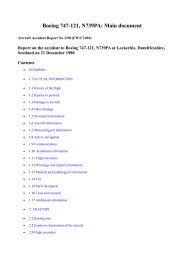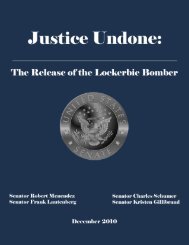REPORT OF THE - Archives - Syracuse University
REPORT OF THE - Archives - Syracuse University
REPORT OF THE - Archives - Syracuse University
Create successful ePaper yourself
Turn your PDF publications into a flip-book with our unique Google optimized e-Paper software.
worldwide responsibility within Pan Am for interpretation of the ACSSP. Several<br />
security problems were covered at the meeting. Pan Am either sought to justify its<br />
procedures or agreed to request written waivers from the FAA when local conditions<br />
prevented Pan Am from complying with the requirements.<br />
The FAA's memorandum of the meeting, however, shows that at least one problem was<br />
raised but not resolved: Pan Am "servicing personnel who boarded the aircraft were not<br />
appropriately examined" at Frankfurt airport, as required by the ACSSP. In April 1986,<br />
Pan Am had decided after "discussion with the FAA" not to screen its own uniformed<br />
and badged servicing personnel, regardless of what was written in the ACSSP. Sonesen<br />
told the Commission that Pan Am had "a working agreement" with the FAA on this<br />
practice. Pan Am never received from the FAA a written exemption from the personnel<br />
inspection requirements. None of the FAA inspectors at Frankfurt cited Pan Am for a<br />
violation of these requirements over the next three years.<br />
Another of the FAA extraordinary procedures that Pan Am found problematic concerned<br />
screening interline, or transfer, passengers who connected with a Pan Am flight from<br />
another air carrier. Connection times could be close, especially at an airport with many<br />
connecting flights such as Frankfurt. Under the FAA extraordinary measures, interline<br />
passengers often fit into a risk "profile," or category, necessitating special screening,<br />
including an X-ray of their checked baggage. This process could cause delays if the bag<br />
of a particular passenger had to be located.<br />
To alleviate this problem, Pan Am purchased additional equipment and in early 1987<br />
began X-raying checked baggage of all interline passengers, whether or not they were<br />
selected for further screening. This procedure satisfied the FAA requirements for<br />
screening baggage accompanying passengers who boarded Pan Am flights. It did not,<br />
however, satisfy FAA extraordinary measures for positive passenger/checked baggage<br />
match, which were intended to control unaccompanied bags.<br />
The FAA written procedures concerning unaccompanied baggage at airports such as<br />
Heathrow and Frankfurt were clear. U.S. air carriers there were prohibited from<br />
transporting any checked baggage not matched with a passenger who actually boarded a<br />
flight, unless the baggage was opened and physically searched.<br />
In the event of a "no-show" passenger whose baggage already had been loaded onto a<br />
plane, for example, the plane could not depart until that baggage was located, off-loaded<br />
and searched. This process was a particular problem for Pan Am at airports with<br />
substantial interline operations.<br />
Picture Not Included<br />
Baggage transfer from one airline to another poses a security problem for all airlines.<br />
Currently, at high risk airports, baggage unaccompanied by a passenger may not be<br />
loaded on U.S. carriers unless separated from a passenger due to no fault of his own.<br />
Martin Huebner, Pan Am's chief of security for West Germany, told the Commission:<br />
"Frankfurt station had problems with the reconciliation of interline baggage.... That<br />
interline baggage had to be sorted out. It had to be checked out with the number of<br />
interline passengers and, of course, was a lot of work."










